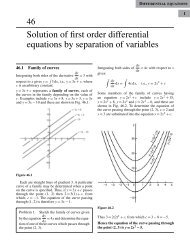vector
Create successful ePaper yourself
Turn your PDF publications into a flip-book with our unique Google optimized e-Paper software.
456 Vectors<br />
Changing to spherical polar coordinates by putting<br />
x = r sin cos , y= r sin sin , z = r cos , dV = r 2 sin dr d d<br />
To cover V, the limits of r will be 0 to 1, those of will be 0 to 2<br />
and those of will be 0 to<br />
2.<br />
<br />
2<br />
2<br />
dV =<br />
V zy<br />
=<br />
=<br />
=<br />
2 /2 1 2 2 2 2<br />
<br />
2 ( r cos )( r sin sin ) r sin drd d<br />
0 0 0<br />
2 /2 1 5 3 2<br />
<br />
2 r sin cos sin<br />
drd d<br />
<br />
0 0 0<br />
<br />
6<br />
1<br />
2 2<br />
3 2<br />
r<br />
<br />
0 <br />
<br />
0<br />
6 0<br />
2 sin cos sin<br />
d d<br />
2 2<br />
=<br />
2<br />
2<br />
sin <br />
6 0 4.2 d<br />
1<br />
12<br />
2<br />
2 <br />
sin d<br />
=<br />
0<br />
12<br />
Example 108. Use Divergence Theorem to evaluate FdS<br />
2<br />
where F 4 xiˆ<br />
–2y ˆj z<br />
2ˆ k<br />
S<br />
and S is the surface bounding the region x 2 + y 2 = 4, z = 0 and z = 3.<br />
(A.M.I.E.T.E., Summer 2003, 2001)<br />
Solution. By Divergence Theorem,<br />
FdS<br />
<br />
= div FdV<br />
S V =<br />
<br />
<br />
V<br />
<br />
ˆ<br />
<br />
ˆ<br />
ˆ <br />
ˆ 2ˆ<br />
2<br />
i j k (4 xi 2 y j z kˆ<br />
) dV<br />
x y z<br />
= (4 4y<br />
2 z)<br />
dx dy dz<br />
=<br />
V<br />
3<br />
dx dy (4 4y 2 z)<br />
dz =<br />
= (12 12y<br />
9)<br />
dxdy<br />
Let us put x = r cos , y = r sin <br />
= (21 12r sin )<br />
r d<br />
dr<br />
=<br />
0<br />
= (21 12 )<br />
=<br />
2<br />
2<br />
2<br />
2 2<br />
21r<br />
3<br />
<br />
d 4r<br />
sin <br />
2<br />
0 <br />
<br />
= <br />
0 0<br />
<br />
0<br />
<br />
<br />
2 2<br />
0<br />
<br />
<br />
2 3<br />
dx dy [4z 4 yz z ] 0<br />
y dxdy<br />
d (21r 12r sin )<br />
dr<br />
<br />
<br />
d (42 32 sin ) (42 32 cos )<br />
2<br />
0<br />
Ans.<br />
= 84 + 32 – 32 = 84 Ans.<br />
^<br />
Example 109. Apply the Divergence Theorem to compute u nds, where s is the surface of<br />
the cylinder x 2 + y 2 = a 2 bounded by the planes z = 0, z = b and where u ix ˆ – ˆjy kz ˆ .<br />
Solution. By Gauss’s Divergence Theorem<br />
u nds<br />
<br />
ˆ = ( u)<br />
dv<br />
V<br />
<br />
ˆ<br />
ˆ<br />
=<br />
ˆ<br />
<br />
ˆ<br />
<br />
i j k ( ix ˆ ˆ<br />
<br />
jy kzdv )<br />
V<br />
<br />
x y z<br />
= x y z<br />
dv<br />
V<br />
<br />
x y z<br />
= 111<br />
dv<br />
V<br />
= dv dx dy dz<br />
V = Volume of the cylinder = a 2 b Ans.<br />
=<br />
V










